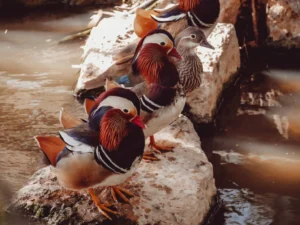Discover the beauty of Mandarin Ducks!
These small and vibrant waterfowl can be found in the most unexpected places, from the tranquil lake on a peaceful street edge to the rushing river tumbling over a rocky fall.
Take the chance to witness their stunning colors and graceful movements in person. Keep your eyes peeled and get amazed by the wonder of Mandarin Ducks!
Discover the joy of spotting these adorable birds!
Whether you’re a seasoned wildlife photographer or a casual birdwatcher, mastering the art of identifying these feathered friends will elevate your experience.
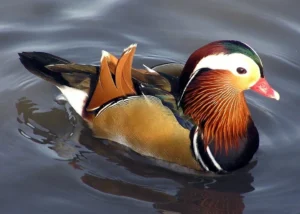
Meet the Mandarin Duck
These bright waterfowl are definitely among the most stunning birds in the family!
To spot a Mandarin duck, watch for its gorgeous feathers! The colors and feather patterns of male and female Mandarin ducks are different.
The males are lovely due to their unique plumage.
With their red beaks, dark purple chests, special golden, orange, white, black, and blue feathers, and blue and olive green, black, and gold-orange crests, these ducks are an incredible sight to behold, while females are dull in their coloring.
Their bills and feathers are the same shade of gray or brown, but they are still distinctively beautiful.
Finally, keep an eye out for their bright orange legs and feet!
Combined with their medium size, these features make it much easier to differentiate Mandarin ducks from other waterfowl species in the wild.
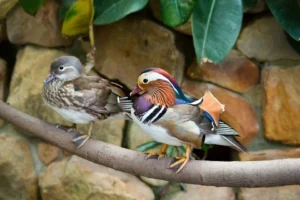
Symbols of Love and Fidelity
You may have heard that Mandarin ducks are symbols of love and fidelity. But do you know why?
There’s an incredible fact that these ducks’ mating habits are incredibly faithful; the pair stays together through thick and thin, sharing parenting duties and migrating together.
It’s been said that if one bird dies, the other will remain a symbol of loyalty and never mate again.
The Chinese first considered this species a lasting love symbol because of its unique pairing behavior.
The duck even appears in centuries-old wedding prints as a reminder of loyalty between husband and wife.
Nowadays, there’s no better way to show someone your commitment than by gifting them with a painting or wood carving of two Mandarin ducks!
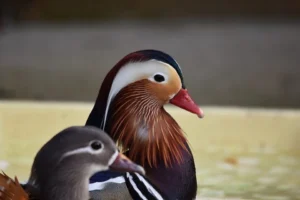
Mating Rituals
Mandarin ducks’ courtship rituals of extravagant displays of affection often signify renewal and transformation. Male Mandarin ducks use their flashy feathers to attract females.
They move their heads and lift their feathers in a particular manner.
During courtship, they also make loud sounds. Mandarin ducks’ mating rituals last around seven days, during which partners may circle each other in the water or display their wings while calling out to one another.
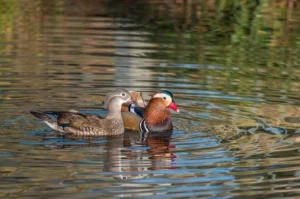
Breeding and Nesting Habits
The breeding season for this species generally occurs between late April and late October.
Mandarin ducks tend to mate in wooded areas close to small ponds or streams, although they have also been observed breeding in flooded or wet areas.
Mandarin ducks build their nests in holes in trees near water And most asked question is How do these birds mate?
They use bark and other plants to close their nests to shallow water. Mandarins also do something called “nest parasitism,” which is when females put eggs in the nests of other females.
The female will lay between eight and twelve eggs, which she’ll incubate for an average of 30 days before hatching.

When male Mandarin looks like female Mandarin
As soon as the mating season passes, the male Mandarin duck begins to shed its feathers.
However, it only sometimes returns to its original brilliance and beauty. Just Imagine how birds look like without feathers?
Instead, it undergoes its dull coloring phase during molting, indicating brown and gray feathers, which gives the bird its female appearance.
Distinguishing between them is often only possible by looking at their beaks. Male birds have bright red beaks, while female birds have grayer beaks.
During the breeding season, male Mandarin ducks undergo another feather change in the fall and return to their colorful period.
The rarity of the Mandarin duck
Mandarin ducks are well-known for being hard to find, especially in the wild. The following are the reasons:
Impact of humans
The main reason behind the dwindling Mandarin duck population is human interference.
Mandarin ducks’ habitats have been destroyed due to the encroachment of civilization, particularly human development of their wetland areas.
As a result, Mandarin ducks have had fewer places to call safe since they need specific ecosystems to survive and thrive.
There are a lot more effects of bird poop, Get to know about reasons why bird poop is white?
Climate change
Climate change has also significantly impacted mandarin duck populations and other waterfowl species worldwide.
With rising water levels and intensifying weather events, mandarin ducks have had more difficulty finding new habitats and adjusting to shifting temperatures.
Poaching
Poaching has caused an extreme drop in Mandarin duck populations.
Hunters want these birds as souvenirs or stuffed animals because of their bright colors and distinctive shapes.
Unfortunately, this often leads to overhunting and a population decrease that cannot be reversed.
Habitat and Distribution
Mandarin ducks are unmistakable, with their bright colors and elegant forms that are the stuff of legends. So, where do they live?
The answer is explicit: Mandarin ducks are found in Asia, specifically Russia, China, Japan, and Korea.
They favor woodlands near wetlands with ample vegetation and trees for nesting.
They also inhabit high mountain streams.
Mandarin ducks migrate less than other waterfowl species; they like to stick to the same areas year after year.
Regarding specific characteristics of their habitats, these ducks prefer places free from disturbance and with good food sources like grasses, grains, and plants.
Trees such as poplars, oaks, and willows provide a cozy nesting environment, ideally near the bank or stream, so their eggs don’t get too wet.
Diet
Mandarin ducks aren’t picky eaters, but there are some things they like to eat more than others.
They (omnivores) eat both plants and animals. Mandarin ducks also include those species of birds that eat cicadas, cracked corn, and niger seeds.
Most of what these ducks eat are plants and small animals. Their preferred foods are grains, veggies, insects, snails, and small fish.
Their diet changes with the season and availability of nutrition. During the breeding season, Mandarin ducks prioritize animal consumption.
In the autumn and winter, Mandarin ducks might switch to a more plant-based diet.
Their environment also has a distinctive impact on their foraging behavior.
When Mandarin ducks dive into the water to search for food, they don’t just stay underwater like other duck species; instead, they often swim between water currents in search of the best food source.
Threats Faced by Mandarin Ducks
There are a few threats facing Mandarin ducks, including:
Destruction of forests and wetlands: These ducks need extensive, undisturbed forests and wetlands to feed and nest in. The increasing destruction of these habitat areas caused by humans is a significant threat.
-
Pollution
Water contamination is a significant issue affecting many waterfowl species—Mandarin Ducks included.
As human populations increase, more and more bodies of water become polluted with industrial and agricultural runoff, making it unsafe for these ducks to live in.
-
Illegal hunting
Though some countries have specific regulations on hunting these ducks, illegal hunting continues to be an issue that threatens the population.
By understanding these threats and doing our part to protect their habitats, we can help conserve Mandarin ducks for generations to come.
Conclusion
In conclusion, The Mandarin Ducks is an iconic, unique waterfowl that has captivated us for centuries.
From its bright and intricate plumage to its diverse habitat, the Mandarin Duck has always had a special place in our hearts.
We hope you enjoy reading this! Let us know in the comment section what you think about this spectacular bird.
[su_box title=”Suggested” title_color=”#a1cf08″]Here are some our other masterpieces![/su_box]
Marvelous Spatuletail is in risk? Act fast before it’s late!

